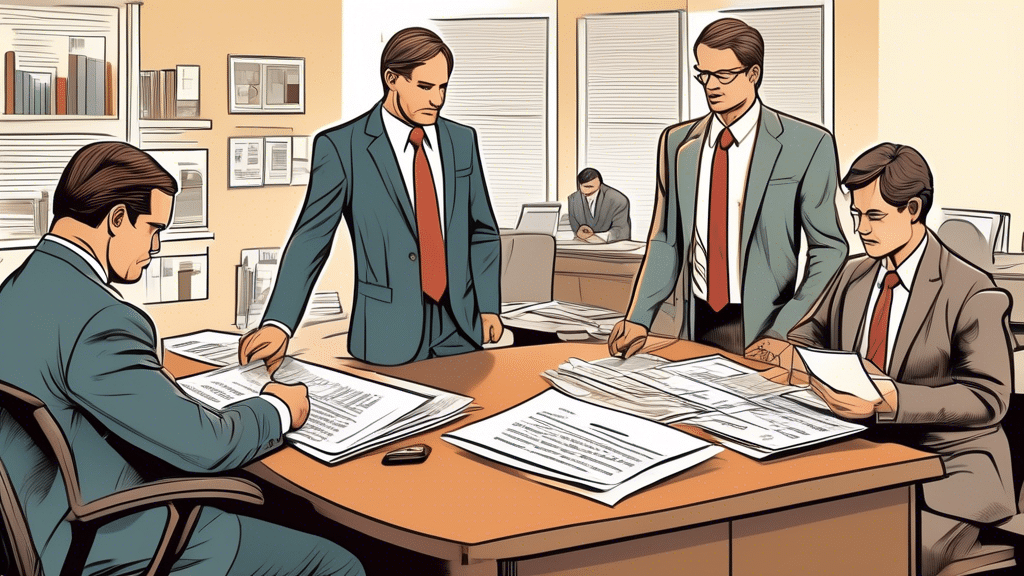Understanding Bankruptcy in Saskatchewan

Tyler McAllister
Senior Finance Writer
Bankruptcy in Saskatchewan is a complex but essential legal process that has significant implications for individuals and businesses struggling with insurmountable debt. Whether due to unforeseen economic downturns, personal financial mismanagement, or industry-specific challenges, understanding the nuances of local bankruptcy laws in Saskatchewan is crucial for navigating this difficult path efficiently.
The bankruptcy process in Saskatchewan involves a series of well-defined steps that include the submission of financial documents, liquidation of assets, and meeting specific legal requirements. However, before embarking on this path, it is wise to explore other debt-relief options such as consumer proposals or debt restructuring, which might offer a less drastic resolution to financial woes.
Licensed Insolvency Trustees (LITs) play a pivotal role in the bankruptcy process in Saskatchewan. These professionals guide debtors through each phase, ensuring compliance with provincial legal standards and safeguarding their rights. After filing for bankruptcy, individuals and businesses must adhere to certain legal obligations, including providing regular financial updates and attending mandatory counselling sessions, to facilitate a smoother recovery and eventual discharge from bankruptcy.
This article aims to offer a comprehensive overview of the bankruptcy process in Saskatchewan, highlight the importance of understanding local bankruptcy laws, and outline the common reasons that lead entities to file for bankruptcy in the province. Whether you are an individual grappling with personal debt or a business facing financial turmoil, gaining a clear understanding of your options and obligations can pave the way to a more secure financial future.
Introduction to Bankruptcy in Saskatchewan
Bankruptcy is often perceived as a daunting, last-resort measure for individuals and businesses grappling with insurmountable debt. In Saskatchewan, understanding the nuances of the bankruptcy process, as well as recognizing the significance of local laws, can demystify this complex procedure and provide clarity to those in financial distress.
Overview of the Bankruptcy Process
The bankruptcy process in Saskatchewan initiates when an individual or business is unable to repay their debts and seeks legal protection. Upon filing for bankruptcy, all legal actions by creditors are temporarily halted, providing the filer with a reprieve. This marks the beginning of a structured process where the debtor’s non-exempt assets are liquidated to repay creditors. While the process can be different for each case, it typically involves several key steps, including the assessment of financial status, filing of the bankruptcy application, and the subsequent period of financial rehabilitation.
One of the pivotal aspects to comprehend about bankruptcy in Saskatchewan is that it aims not only to alleviate the immediate financial burden but also to offer a fresh start. The process is governed by federal laws under the Bankruptcy and Insolvency Act (BIA), but there are specific provincial regulations and exemptions that play a vital role. Understanding the particulars of the Saskatchewan bankruptcy process helps in navigating through what is an inherently challenging period with greater ease and confidence.
Importance of Understanding Local Bankruptcy Laws in Saskatchewan
It is crucial to have a firm grasp of both federal and provincial regulations when contemplating bankruptcy in Saskatchewan. Local bankruptcy laws dictate various exemptions that protect certain assets from being liquidated. For instance, provincial exemptions might include a primary residence up to a specific equity threshold, essential clothing, tools necessary for one’s trade, and certain amounts of RRSP savings. These exemptions are designed to ensure that the person or business filing for bankruptcy is not left destitute and can maintain a basic standard of living or operational capacity.
Moreover, the enforcement and administration of bankruptcy laws can vary by locale, making it all the more important to seek guidance from professionals well-versed in Saskatchewan’s legal landscape. Knowing local laws helps in crafting a more strategic approach to managing debt and can significantly influence the outcome of the bankruptcy process.
Common Reasons Individuals and Businesses File for Bankruptcy in Saskatchewan
Several factors can lead to the unfortunate decision to file for bankruptcy. For individuals, common reasons often include an overwhelming accumulation of consumer debt, such as credit card debt, personal loans, and unpaid utility bills. Medical expenses, especially those unforeseen and not completely covered by insurance, can quickly drain financial resources and lead to insolvency. Job loss or reduced income is another frequent cause, where a sudden drop in earnings makes it impossible to keep up with regular financial commitments.
Businesses in Saskatchewan face their own set of challenges that can precipitate bankruptcy. Poor cash flow management is a significant factor, where businesses find themselves unable to cover operational costs and meet debt obligations. Market changes, such as a decrease in demand for products or services, can also lead to financial instability. Additionally, unexpected disruptions, such as natural disasters or economic downturns, can severely impact a business’s viability. Inefficiencies in business operations and high fixed costs without corresponding revenue can further exacerbate financial woes.
In summary, understanding the bankruptcy process in Saskatchewan, along with the importance of local bankruptcy laws and the common reasons leading to such financial distress, provides a comprehensive foundation for anyone facing financial turmoil. Equipped with this knowledge, individuals and businesses can make informed decisions and navigate through bankruptcy with greater assurance.
See if you qualify for debt relief

Steps and Options for Filing Bankruptcy in Saskatchewan
Filing for bankruptcy can be a daunting process, but understanding the steps involved in bankruptcy in Saskatchewan can help ease the stress. This section outlines the detailed procedures and alternative debt relief options available before considering bankruptcy. Furthermore, we’ll explore the role of Licensed Insolvency Trustees (LITs) and the legal obligations following a bankruptcy filing.
Detailed Explanation of the Bankruptcy Filing Process in Saskatchewan
The process of filing for bankruptcy in Saskatchewan typically involves several key steps:
- Initial Consultation: The first step is to meet with a Licensed Insolvency Trustee (LIT). The LIT will review your financial situation, discuss your options, and help you determine if bankruptcy is the right choice or if another solution might be more appropriate.
- Filing the Application: If bankruptcy is deemed necessary, the LIT will help you complete and file an application. This includes submitting a comprehensive list of your assets, liabilities, income, and expenses.
- Automatic Stay of Proceedings: Upon filing for bankruptcy, an automatic stay comes into effect, halting most creditor actions against you. This means creditors cannot contact you or take legal action, giving you some breathing room to deal with your debts.
- Meeting of Creditors: Occasionally, a meeting of creditors is required. This meeting gives creditors a chance to ask questions about your bankruptcy and financial affairs. In many cases, though, this meeting is not necessary.
- Asset Liquidation: The LIT will take control of your non-exempt assets, which will be sold to pay off your debts. Certain assets, like some personal belongings and tools necessary for your trade, may be exempt from seizure.
- Debtor Duties: As part of the bankruptcy process, you will be required to complete certain duties, such as attending credit counseling sessions, providing financial information to the LIT, and making payments if you have surplus income.
- Discharge from Bankruptcy: The final step in the bankruptcy process is the discharge, which releases you from your unsecured debts. The timing of the discharge can vary, typically taking nine months for a first-time bankrupt with no surplus income, or longer depending on individual circumstances.
Other Debt-Relief Options Available Before Considering Bankruptcy
Bankruptcy is not the only option if you’re struggling with debt. Here are some alternative debt relief options to consider before filing for bankruptcy in Saskatchewan:
- Debt Consolidation: This involves combining multiple debts into a single loan with a lower interest rate. This can make repayment more manageable and reduce overall interest costs.
- Consumer Proposal: A consumer proposal is a legally binding agreement between you and your creditors to repay a portion of your debts over a period of up to five years. This option can allow you to keep your assets and avoid bankruptcy.
- Credit Counseling: Credit counseling agencies can help you create a budget, manage your finances, and negotiate with creditors for a debt management plan. This can be an effective way to address debt without resorting to bankruptcy.
- Debt Settlement: Debt settlement involves negotiating with creditors to settle your debts for less than the full amount owed. This can be a viable option for those who have a lump sum of money available to offer creditors as full payment.
Role of Licensed Insolvency Trustees (LITs) in Saskatchewan
Licensed Insolvency Trustees (LITs) play a crucial role in the bankruptcy process in Saskatchewan. Here’s how they assist individuals and businesses:
- Consultation and Advice: LITs provide initial consultations to assess your financial situation and advise on the best course of action, whether it be bankruptcy, a consumer proposal, or another debt relief option.
- Administration of Bankruptcy: If you decide to file for bankruptcy, the LIT administers the entire process. This includes preparing and filing the necessary documents, notifying creditors, and overseeing the liquidation of your assets.
- Credit Counseling: As part of the bankruptcy process, LITs conduct mandatory credit counseling sessions to help you understand the reasons for your financial difficulties and develop strategies to avoid similar problems in the future.
- Debt Reduction Negotiations: When appropriate, LITs can negotiate with your creditors to reduce the amount of debt you owe, potentially through a consumer proposal.
Legal Obligations and Requirements After Filing for Bankruptcy in Saskatchewan
After filing for bankruptcy in Saskatchewan, there are several legal obligations and requirements you must fulfill:
- Financial Disclosure: You must provide accurate and complete information about your financial situation, including all assets, liabilities, income, and expenses. Failure to fully disclose can result in penalties or dismissal of your bankruptcy application.
- Credit Counseling Sessions: You are required to attend two mandatory credit counseling sessions. These sessions aim to educate you on money management, budgeting, and financial planning to help prevent future financial issues.
- Surplus Income Payments: If you earn above a certain threshold, you may be required to make additional payments to your LIT during the bankruptcy period. These payments are based on the surplus income you have after meeting your basic living expenses.
- Cooperation with the LIT: You must fully cooperate with your LIT throughout the bankruptcy process. This includes providing all necessary documents and information promptly and attending required meetings or examinations.
- Tax Returns: You will need to file any outstanding tax returns, and your LIT may file returns on your behalf for the bankruptcy year.
By understanding these steps and alternatives, and recognizing the support provided by Licensed Insolvency Trustees, you’ll be better equipped to navigate the complexities of bankruptcy in Saskatchewan. This knowledge can help you make informed decisions and achieve a fresh financial start.
In conclusion, understanding bankruptcy in Saskatchewan is essential for individuals and businesses facing financial distress. The bankruptcy process involves a series of well-defined steps designed to provide a fresh start while ensuring fairness to creditors. Recognizing the local laws specific to Saskatchewan’s bankruptcy proceedings can significantly impact the outcome and ease of the process. Typically, individuals and businesses file for bankruptcy due to insurmountable debt, economic downturns, or unexpected financial crises.
Before opting for bankruptcy, it is crucial to explore all available debt-relief options. Saskatchewan provides several alternatives that might better suit individual circumstances, potentially avoiding the long-term consequences of bankruptcy. Licensed Insolvency Trustees (LITs) play a pivotal role in navigating the bankruptcy process. They offer professional guidance, helping debtors meet legal obligations, and fulfilling requirements mandated by the bankruptcy laws in Saskatchewan.
Given the complexities and legal intricacies involved, seeking advice from a qualified LIT can make a substantial difference in managing the financial aftermath. By gaining a comprehensive understanding of the steps, options, and legal responsibilities associated with bankruptcy in Saskatchewan, individuals and businesses can make informed decisions to restore financial stability and prepare for a more secure future.
See if you qualify for debt relief
